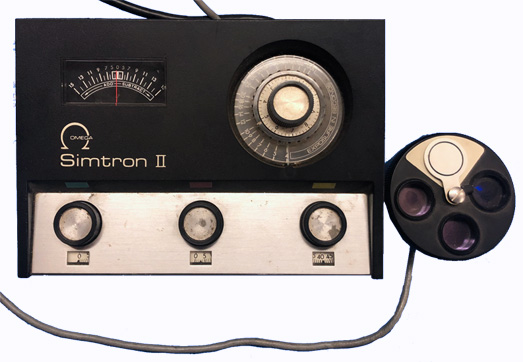 |
  Maker: Omega Model: Simtron II Circa: 1975 Cell type: CdS Measure type: Enlarging/Color Analyzer Modern Photography Test: April 1975 |
||||||||||||||||||||||||||||||||||||||||||||||||
|
You do something similar with the color, except that you use a diffiuser to blend all the colors together. You start with standard negative (or transparency) and make a print you like. Then you put the diffiuser under the lens, put the sensor under it, and for each color channel (cyan, magenta and yellow) you null out the meter. For your next negative you place the diffuser under the lens, put the sensor under that, and the meter tells you which filters you need to print it. These meters work well if you spend the time to get them set up. They usually won't give you a perfect exposure or color pack, but they'll get you in the ballpark without making a lot of test prints. Color work in particular was and remains expensive and time consuming; anything that shortens the drudgery is welcome. This unit is a nice because it's fairly small and it has a bracket to mount it on the wall, and it's simple enough that you can figure it out without an instruction manual (which I didn't have when i was using it). It also has a little tab to protect the sensor from bright light, something sorely lacking in my Labosix. The only thing I don't like about it is that it has a big sensor cell, which is fine if you're using the diffuser to read the color cast, but not good at all if you're trying to read small spots on the negative for exposure (i.e. zone system work). The Beseler PM2L has a small sensor that would be better for spot measuring. Unfortunately, I never did a head-to-head comparison. If I ever get back into the darkroom, that's something I would like to do. |
|||||||||||||||||||||||||||||||||||||||||||||||||
| Name | Probe Type | Probe Aperture | Cosine Corrected | Control Knobs per Channel | Adjustable Sensitivity | Memory Modules | Optical Density Scale | Display Size | Readability |
Price | Comments |
|---|---|---|---|---|---|---|---|---|---|---|---|
| Omega SCA 100 | Silicon | 5mm | yes | 1 | no | no | no | 2 in. | back-lit |
$200 | Compact 1-piece unit |
| Omega SCA 300 | Silicon | 3, 5mm | yes | 1 | no | yes ($41.95) | no | numbers 5/16 in. high | digital |
$800 | Light detector uses 3 silicon cells, 8-foot probe cord for large prints |
| Omega SCA 400 | Silicon | 3, 5mm | yes | n/a (comments) | no | yes (8) | no | numbers 5/16 in. high | digital |
$2,000 | Light detector uses 3 silicon cells, simultaneous 4-channel readout, built-in timer (1983) |

-sm.jpg)